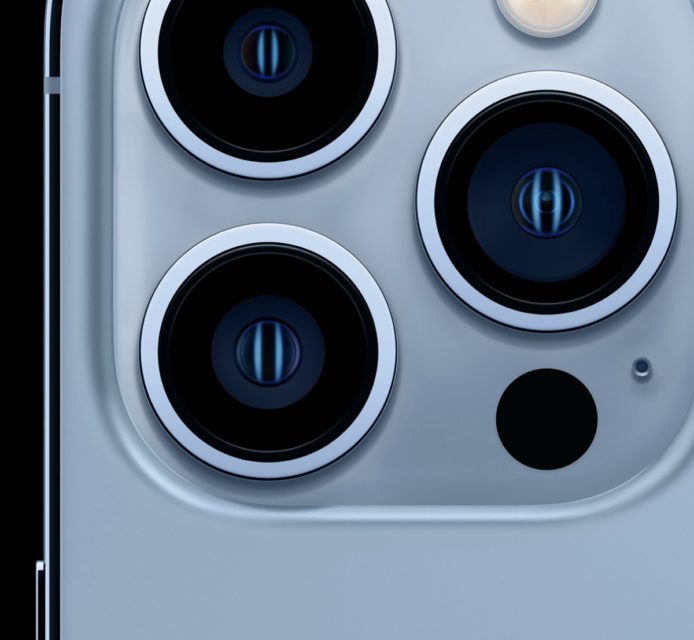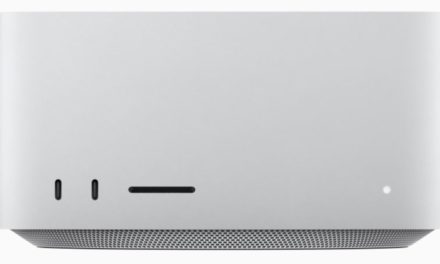My iPhone is one of my most used electronic devices. It serves as my camera, video recorder, voice recorder, GPS — and, of course, my phone. With it filling all these jobs, I’m willing to pay for the best model I can afford.
This year, it’s the iPhone 13 Pro Max with 512GB of storage. (I couldn’t rationalize springing another $200 for 1TB of storage.) I bought the Sierra blue version.
There’s a lot to love about the latest high-end iPhone. My three favorite new features are the improved cameras, battery life, and addition of ProMotion.
Improved cameras
The pro camera system gets a major upgrade thanks to the new Ultra Wide, Wide, and Telephoto cameras that capture incredible photos and videos. Thanks to the beefy A15 Bionic processor the iPhone 13 Pro and iPhone 13 Pro Max can take on new photo capabilities like macro photography on the Ultra Wide camera and up to 2.2x improved low-light performance on the Wide camera.
The Wide camera has a larger sensor with 1.9 µm pixels, which is the largest ever on iPhone. This means less noise and faster shutter speeds for photos with more details. Coupled with the larger ƒ/1.5 aperture, the Wide camera on iPhone 13 Pro and iPhone 13 Pro Max offers a massive improvement in low-light situations, up to 2.2x when compared to iPhone 12 Pro, and nearly 1.5x when compared to iPhone 12 Pro Max. Sensor-shift optical image stabilization (OIS) stabilizes the sensor instead of the lens. This keeps images relatively smooth and video relatively steady, even when you’re not.
The new Ultra Wide camera features a wider ƒ/1.8 aperture and a new autofocus system. Apple says this brings a 92% improvement for low-light environments for brighter and sharper images.
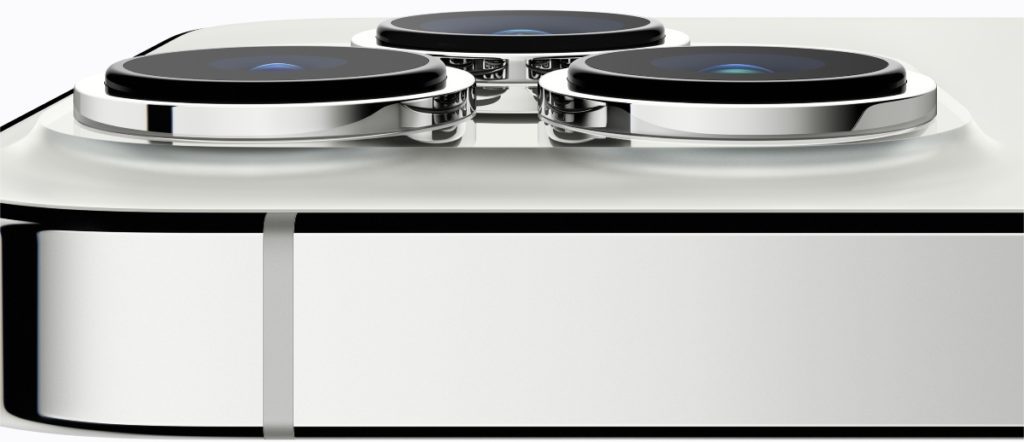
The new lens design brings autofocus capability for the first time in the Ultra Wide on iPhone. Enhanced software makes macro photography possible on the iPhone. You can capture images where objects appear larger than life. Subjects can be magnified with a minimum focus distance of two centimeters.
You should note that iOS 15 falls to turn off automatic camera switching when shooting at close distances for macro photography and video. Apple says this will be fixed in an upcoming software update.
Macro also extends to video including Slo-mo and Time-lapse. iPhone 13 Pro and iPhone 13 Pro Max also boast a new 77 mm Telephoto camera. This allows you to get closer to subjects while recording video. The iPhone 13 Pro and 13 Pro Max are also equipped with 3x optical zoom for a total 6x optical zoom range.
New computational photography features like Photographic Styles personalize the look of images in the Camera app. Photographic Styles is basically just an advanced filters system, but it’s fun to use.
Both the iPhone 13 Pro and 13 Pro Max include Night mode on all cameras. Night mode is a very cool feature. You can use it to capture photos when the iPhone camera detects a low-light environment. Night mode automatically turns on when the camera detects a low-light environment.
Also, the new iPhone 13 Pro models support 4K ProRes video recording. If you want to capture video at the highest quality, you’ll need at least 256GB of storage space. I’d recommend the 512GB model if you’re doing to be using the smartphone for lots of video recording.
And don’t just take my word for it. Check out this tidbit from DXO Mark’s test of the iPhone 13 Pro’s camera system: With a DXOMARK Camera overall score of 137 the Apple iPhone 13 Pro mingles among the very best devices in our camera ranking. The overall score is compounded by an excellent Photo score of 144. Like for all iPhones color rendering is vivid with nice skin tones and a slightly warm touch and the camera is generally very reliable. Overall Photo performance is quite similar to the 12 Pro we tested last year but improvements have been made in several areas.
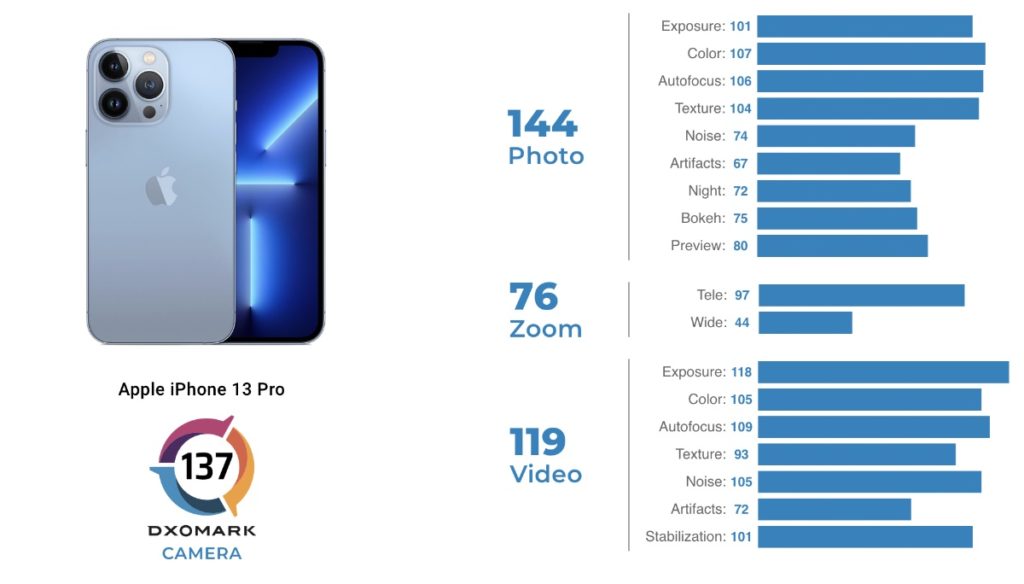
I’m also mostly impressed with Cinematic Mode, which allows you to shoot Dolby Vision HDR. It handles both automatic and manual rack focus, while storing focus information in the video data so you can change it even after the video has been recorded.
Here’s Apple’s explanation of Cinematic Mode: Following extensive study of cinematography and the powerful use of rack focus, Cinematic mode on iPhone records videos of people, pets, and objects with a beautiful depth effect with automatic focus changes, so anyone can capture cinema-style moments, even if they aren’t a professional filmmaker. For creative control, the focus can be changed during and after capture, and users can also adjust the level of bokeh in the Photos app and iMovie for iOS, and coming soon to iMovie for macOS and Final Cut Pro,1 making the lineup the only devices able to edit the depth-of-field effect in video even after recording. Enabled by A15 Bionic and advanced machine learning algorithms, Cinematic mode records in Dolby Vision HDR.
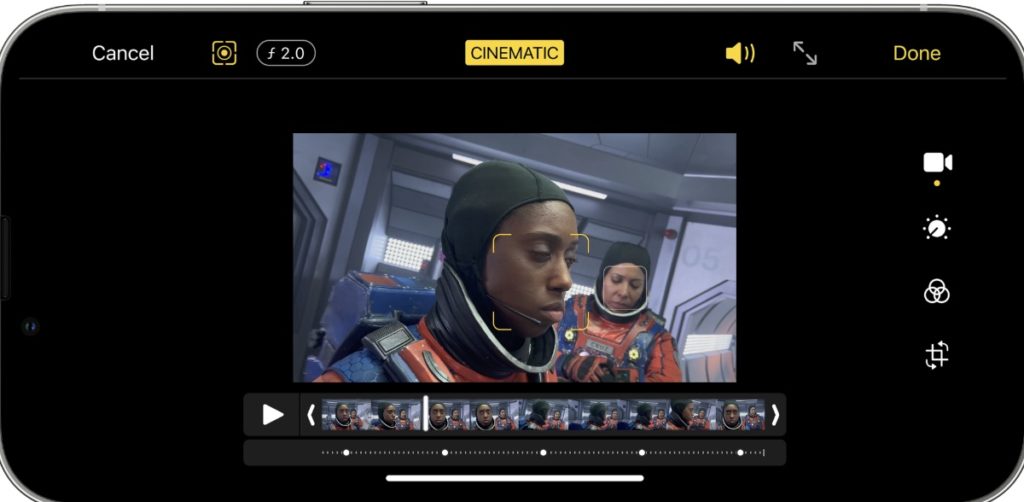
The disappointing thing about Cinematic Mode is that it’s limited to1080p and 30fps. 4K support would be great. Of course, 4K videos would eat up even more storage space, but still….
By the way, all iPhone 13 models are 0.01 inches thicker than the iPhone 12 models thanks to the larger camera array. They’re also from 5-8%t heavier, depending on the model.
ProMotion
The iPhone 13 Pro and Pro Max sport a Super Retina XDR display with ProMotion featuring an adaptive refresh rate up to 120Hz. According to Apple, ProMotion provides “fluid scrolling, greater responsiveness and smoother motion content” and “improves display quality and reduces power consumption by automatically adjusting the display refresh rate to match the movement of the content.”
As users of the iPad Pro know, this is true. 120Hz refreshes four times faster than 30Hz and two times quicker than 60Hz, producing smoother motion and transitions. Faster update times also mean lower latency, because the pixels are being refreshed more often. In other words, the iPhone 13 Pro Max zips through home screens, launches apps lightning fast, and provides smoooooth scrolling.
Battery life
More battery life is always a good thing. And my iPhone 13 Pro Max ran for about 10 hours (continuous usage) on a single charge. That’s about two hours longer than my iPhone 12 Pro Max lasted on a full charge. This is an impressive, welcome change that’s it’s possible due to the larger battery capacity and more power efficient A15 Bionic chip.
The A15 Bionic chip
The Apple-developed A15 Bionic chip is build with 5-nanometer and features a new 5-core GPU in the Pro lineup. Apple says the A15 is the fastest chip in any smartphone and that the graphics in the iPhone 13 line-up are up to 50% faster than the leading competition.
I can’t vouch for those statistics. However, I can vouch that the A15-equipped smartphones are excellent for gaming and tackling all the previously mentioned heavy-duty photography/videography tasks. The new 6-core CPU with two new high-performance cores and four new high-efficiency cores is also purportedly up to 50% faster than the competition.
A new 16-core Neural Engine is capable of 15.8 trillion operations per second, which means even faster machine learning computations for third-party app experiences, as well as features like Live Text in Camera with iOS 15. And, per Apple, major advancements to the next-generation ISP provide improved noise reduction and tone mapping.
As Tom’s Guide puts it, “If having the best performance is a top priority for you, then you’ll want to look at the iPhone 13 or iPhone 13 Pro/Pro Max.”
iPhone 13 Pros and 5G
The iPhone 13 lineup now includes several new 5G bands: most notably n48 or CBRS. However, the U.S.-only model is the only one with millimeter-wave 5G.
However, the iPhone 13 also won’t feature 5G band n53, which is the ground-based 5G band owned by satellite operator. So, despite earlier rumors, Apple’s newest smartphone won’t feature low earth orbit (LEO) satellite communication connectivity to will allow users to make calls and send messages in areas without 4G or 5G coverage.
PCMag lead 5G and mobile analyst Sascha Segan tested the 5G capabilities of the iPhone 13 against previous models to see if it’s really worth upgrading for. The result is that the iPhone 13 won’t give you better 4G/5G performance than the iPhone 12 for now, but it has features designed for the future, and it’s far better than the 11 and XR. Key highlights from Segan’s test:
- The iPhone 13 adds 5G carrier aggregation, which T-Mobile has started to use to improve 5G range, speed, and latency. Important, since T-Mobile’s mid-band won our speed tests across the nation as the Fastest Mobile Network this year.
- The iPhone 13 also adds 5G band n48, or CBRS, which Verizon aims to use to enhance its upcoming C-band network. The iPhone 12 supports C-band but not 5G CBRS.
- Compared to iPhone 12 models, we did not get better signal strength or range on the iPhone 13. 5G speeds were comparable on Verizon and T-Mobile.
- Wi-Fi 6 performance tested at various distances was also the same as on the iPhone 12 series.
- Combining its future-friendly 5G with much better battery life (per our battery comparisons) the iPhone 13 makes a strong argument as a smarter buy than the iPhone 12 series.
Other details
° The iPhone 13 Pro and iPhone 13 Pro Max models are equipped with 6GB of RAM, while the iPhone 13 and iPhone 13 mini have 4GB of RAM. These amounts are unchanged from the iPhone 12 lineup.
° iPhone 13 models feature a more power efficient A15 Bionic chip based on TSMC’s advanced 5nm+ process. However, Apple hasn’t released any info on how much faster it is compared to its A14 predecessor. What’s more, the A15 chip boasts a new 5-core GPU in iPhone 13 Pro and Pro Max models; that’s up from four cores.
° The iPhone 13 Pro and iPhone 13 Pro will now be able to use two eSIMs in a single iPhone in all markets (well, depending on carrier support).
Things that disappoint me
I was hoping that the iPhone 13 could be the model that gave us an an always-on display This would allow an Apple Watch-like always-on mode” that shows useful info like time, date and notifications even when the screen is turned off. But such a feature didn’t appear.
Also, despite a smaller notch, the iPhone 13 models don’t, by default, show the battery percentage in the status bar. I find this irritating. To check the battery percentage on the smartphone:
° Swipe down from the upper-right corner of your iPhone 13’s display in portrait or landscape mode to access Control Center.
° You should now see the hidden battery percentage along with other hidden status bar icons for Bluetooth and Location Services.
Review overview
The Pros
- Excellent photo
- video features
- Fantastic screen
- Incredibly powerful
The Cons
- No always-on display
- Doesn’t show battery life on the home screen
summary
9.9Despite a few disappointments, I’m extremely pleased with my iPhone 13 Pro Max. If you want the ultimate smartphone when it comes with features, power, and battery life, this is for you.
Article provided with permission from AppleWorld.Today

